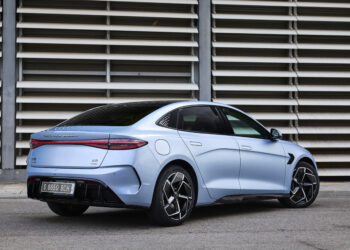What’s more, BYD made waves in the electric vehicle world last year when it unveiled its affordable car, the BYD Seagull. The vehicle is a BYD’s Ocean family member and sits below the Dolphin in BYD’s hierarchy.
Its offering will see it compete with small Chinese EVs such as the Changan BenBen E-Star and Chery Wujie Pro. The compact electric car has been causing a stir with consumers and industry watchers alike in China for its low price, under $10,000.
In this blog, we’re going to dive into what makes the Seagull so cheap for BYD and how these efficiencies could revolutionise not just the automaker, but the entire automotive industry worldwide.
Design and Features
A single electric motor that produces 75 horsepower (55 kW) and 135 Nm of torque power. It has a top speed of 130 km/h and can accelerate from 0 to 50 km/h in 4.9 seconds.
It is available with two different BYD Blade battery pack options: a 30.08 kWh pack providing a range of up to 305 km and a 38.88 kWh pack that can deliver up to 405 km. Both are under the CLTC standard, which is generally more optimistic than Western standards like the EPA.
The Seagull supports fast charging, recharging the battery from 30% to 80% in 30 minutes. This feature, combined with its competitive starting price—which in China is around $10,000—makes the Seagull a compelling option for many consumers, offering a good balance of cost and functionality.
The interior of the Seagull is designed with modern features, including a 10.1-inch rotating infotainment screen that supports smart connectivity functions like voice control, CarPlay, and Android Auto.
BYD’s e-Platform 3.0 enhances the vehicle’s safety and structure, contributing to its robustness and driving dynamics.
Key Factors Behind Low Cost
BYD Seagull has captured consumer interest due to its meager price. So, we wanted to know how BYD achieved this feat. Let’s explore the key factors behind the Seagull’s affordability.
1. Vertical Integration
Vertical integration is a business strategy where a company controls multiple stages of its production process, typically including the supply chain, manufacturing, and distribution stages. This approach aims to reduce costs, improve efficiency, and gain more control over the entire process.
BYD’s vertical integration strategy is crucial to reducing costs. The company controls much of its supply chain, including the production of batteries, one of the most expensive components of an electric vehicle.
By manufacturing its batteries, BYD ensures a steady supply and reduces costs associated with third-party suppliers. In 2023, BYD’s battery manufacturing capacity was about 65 GWh, positioning it as a leader in battery production and significantly lowering the cost of its EVs.
2. Cost-Saving Design Choices
The Seagull incorporates several cost-saving design features, such as a single windshield wiper and a minimalist interior. These choices reduce the number of components and simplify manufacturing, further lowering costs.
In addition, BYD’s advanced manufacturing processes and continuous innovation contribute to cost efficiency. The company invests heavily in research and development, optimizes production techniques, and reduces waste. This focus on innovation ensures that BYD remains competitive while maintaining high-quality standards.
3. Efficient Battery Technology
As we already mentioned, BYD produces in-house batteries for Seagull using lithium iron phosphate (LFP) batteries, which are cheaper to produce than other types of lithium-ion batteries. This choice of battery technology contributes to the overall affordability of the vehicle.
4. Economies of Scale
BYD’s large-scale production capabilities allow the company to achieve economies of scale. In 2023 alone, BYD sold 3 million vehicles worldwide, leveraging its vast production capacity to reduce per-unit costs.
5. Competitive Pricing Strategy
BYD’s pricing strategy for the Seagull is also designed to penetrate the market aggressively. By offering the Seagull at a lower price point, BYD aims to capture a larger market share, especially among cost-conscious consumers in China and elsewhere. This strategic pricing attracts new buyers and pressures competitors to reconsider pricing structures.
6. Government Subsidies
According to a German Think Tank Kiel Institute study, the Chinese government offers more subsidies than OECD countries like the US and Germany.
According to the study, the Chinese government offers 3 to 9 times more subsidies than OECD countries, and BYD is one of the primary beneficiaries.
In recent years, the electric vehicle manufacturer BYD has benefited significantly from government subsidies. In 2020, BYD received approximately $260 million in direct subsidies, which dramatically increased to around $2.4 billion by 2022.
Regarding business revenues, direct subsidies increased from 1.1 percent in 2020 to 3.5 percent in 2022. Additionally, BYD receives significantly higher purchase premiums for electric cars in China than domestic manufacturers like GAC or foreign companies producing locally, such as Tesla or VW’s joint ventures.
Competitors on Edge
The success of BYD Seagull’s low price point has caused ripples in the electric vehicle market. Competitors increasingly worry about BYD’s ability to offer high-quality EVs at such competitive prices.
Several leaders, such as Ford’s CEO Jim Fraley, have said, “If you cannot compete fairly and squarely with the Chinese around the world, then 20% to 30% of your revenue is at risk over the next several years.”
Other automakers are now facing the challenge of reducing their prices to match BYD or finding innovative ways to add value to their vehicles to justify higher prices. This scenario creates a dynamic and competitive market, benefiting consumers with more choices and better pricing.
The pressure on competitors to innovate and reduce costs can lead to more affordable and advanced electric vehicles in the future. As the market evolves, it will be fascinating to see how other players respond to BYD’s disruptive pricing strategy.





